

“Texas flag, painted on boarded-up window in Brownwood, the seat of Brown County in Central Texas. Original image from Carol M. Highsmith’s America, Library of Congress collection. CC0 1.0
This article was originally published in the Mexican American Civil Rights Institute’s inaugural Brown Paper Series
The 2018 midterm election sounded creaking noises in Texas, suggesting that the long-anticipated demographic wave would turn the state blue. It did not happen in 2018, but surely, the thinking went, 2020 would be the year. To add to the intrigue, Latinos accounted for three of every five new Texans eligible to vote, and grassroots organizations were making great headway in registering Latino voters.
Early in the night, as polls closed across Texas, it became clear that Texas was taking some steps backward in turning blue. The shift in the political momentum shift was much clearer in 2018, when Beto O’Rourke nearly beat Ted Cruz and Democrats flipped two U.S. House seats, two Texas state senate seats, and seven Texas state house seats.
Two years later, nothing to write home about: Democrats took away a Texas Senate seat, a Texas House seat, and ceded a U.S. House seat and a Texas House seat to Republicans. Furthermore, Trump soundly beat Biden by nearly 6 percentage points, and John Cornyn kept his U.S. Senate seat, blowing past M.J. Hegar by close to 10 percentage points. And despite his bashing of Latinos and erecting a border wall along the Texas-Mexico border, Latinos increasingly voted for Trump, more so than they had four years earlier.
Political pundits have tried to make sense of the outcome in Texas, an especially disappointing one for those who want to see the state turn blue. In this essay, I provide my analysis of what happened, the challenges that we face, and the opportunities that we have in turning Texas blue.
Lessons learned from the 2020 election
Post-election analyses draw out the political complexities that are part of the Latino political landscape in Texas. One New York Times analysis of 28,000 precincts across more than 20 large cities in the country indicates that while Biden won in these sites, the percentage increase of votes between 2016 and 2020 was much greater for Trump compared to Biden (relative to Hillary Clinton votes in 2016). For example, although Biden beat Trump by 50 percentage points in Cook County, home to Chicago, Gage Park, Humboldt Park, Little Village, and Pilsen–neighborhoods where Latinos make up more than half of the population–Trump received 45 percent more votes in 2020 than four years earlier, while there was no change in the Democratic vote. Similar trends occurred in Orlando, Philadelphia, New York City, Phoenix, and Los Angeles.
In Texas, too, this trend persisted, with the precincts shifting politically rightward being those with relatively larger Latino populations. In their New York Times analysis, Cai and Fessenden note that, in Texas, the “Democratic margin in 80 percent Latino precincts dropped an average of 17 percentage points.” In McAllen, the number of votes cast for Trump rose 93 percent between 2016 and 2020 while the Democratic vote rose by 7 percent. Other research examining a different set of areas–Phoenix, Milwaukee, Las Vegas, Miami, Paterson, New Jersey, and the Rio Grande Valley–has also shown this trend associated with a large percentage gain in votes for Trump, compared to a flat line or declining votes for Biden.
This political shift occurred particularly in the Texas border region. In the 14 border counties that Biden won, Trump gained a considerable portion of the vote, ranging from nearly one-third in El Paso County to close to half in Culberson and Starr counties. Trump won six border counties, most prominently Zapata County, where he beat Biden by 5 percentage points, and where four years earlier Hillary Clinton beat Trump by 30 points.
Four important lessons emerge from the outcome of the November 2020 election. These illustrate the significant challenges that we face within the Latino community and within the Democrat Party.
First, the 2020 election reminded us that Latinos are a diverse population in many ways, but particularly in their politics. Long have we realized that there is a sizable portion of the Latino population that is politically conservative and who regularly provides support for Republicans. I think that the Latino left, myself included, has been in denial of this fact to a certain degree, perhaps suggesting that this segment is smaller than it actually is, and that eventually these misguided brethren will have an epiphany—the aha moment when they realize that Republicans do not have their interests at heart.
Second, political observers have indicated that Latinos along the border may also be voting for their own particular economic interests. Along the border, law enforcement, border patrol, and Homeland Security jobs are plentiful and provide stable income, along with benefits not found in many jobs located in the region. The energy sector is another industry associated with job growth and tied to Republican political interests.
I put together data from the 2019 American Community Survey (ACS) five-year estimates for the 2015-2019 period to identify occupations, industries and college majors where Latinos living along the border, who are 18 or older and U.S. citizens, are disproportionately clustered relative to their counterparts in the interior of the state. The border region includes Public Use Microdata Areas (PUMAs) that are located approximately 100 miles from the Texas-Mexico border; interior regions are all other PUMAs.
There are eight occupations with at least 1,000 Latino workers in the border region, in which border Latinos are at least 1.75 times more likely to be employed compared to their counterparts living in the interior (Table 1). These include the following occupations: detectives and criminal investigators (3.10 border Latinos per 1 interior Latino); other extraction workers (2.67); police officers (2.53); underground mining machine operators (2.23); correctional officers and jailers (1.97); probation officers and correctional treatment specialists (1.85); security guards and gaming surveillance officers (1.75); and derrick, rotary drill, and service unit operators, and roustabouts, oil, gas, and mining (1.75). Yet, overall, Latinos on the border who hold law-enforcement, security, or energy jobs represent a small share (3.8 percent) of the entire Latino workforce in the border region.
Table 1. Eight Selected Occupations Where Border Latinos are Disproportionately Working Compared to Latinos in Interior, 2015-2019
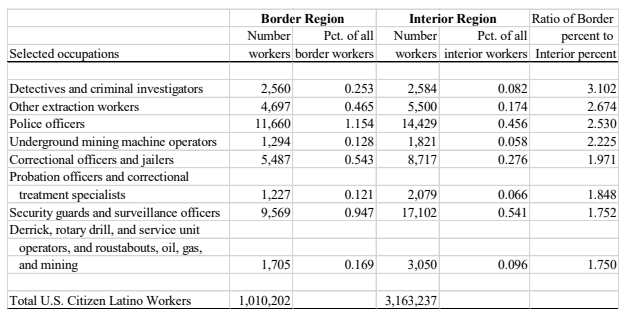

Source: 2019 American Community Survey 5-Year Estimates
In addition, there are three industries in which border Latinos are more than 1.75 times as likely to work compared to Latinos in the rest of the state: justice, public order, and safety activities, (1.85); national security and international affairs (1.84), and support activities for mining (1.77). Again, however, Latinos working in these three industries make up a small (6.5 percent) portion of all Latino workers in the border area.
Table 2. Three Selected Industries Where Border Latinos are Disproportionately Working Compared to Latinos in Interior, 2015-2019


Source: 2019 American Community Survey 5-Year Estimates
Moreover, Latinos who are U.S. citizens and who have at least a bachelor’s degree living on the border are much more likely to have majored in criminal justice and fire protection than Latinos living in the interior of the state. Criminal justice and fire protection is the third most common major for border Latinos while it ranks eighth among Latinos in the rest of the state. Border Latinos with a bachelor’s degree are approximately 1.75 more likely to have majored in criminal justice and fire protection compared to those in the interior of the state. Once again, however, the share of criminal justice majors among all the majors of Latino college graduates in the border region is small (6.5 percent).
Table 3. Top Ten Majors of Latinos with a Bachelor’s Degrees or Higher by Geographic Location, 2015-2019
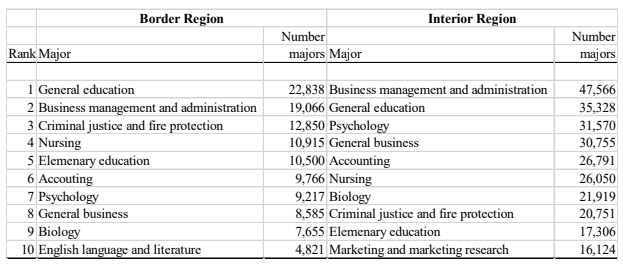

Source: 2019 American Community Survey 5-Year Estimates
Thus, these data show a greater prevalence of employment in law enforcement and criminal justice, and to a certain degree the energy sector, among Latinos living on the border compared to those living in other parts of the state. Yet, persons working in these occupations and industries, or who have majored in criminal justice, represent a small share of the overall workforce or majors of college graduates in the border region. Still, there are likely to be spillover effects of influence, as family and friends associated with these jobs and diploma holders recognize their economic interests.
Third, the state and national Democratic leaderships need to stop taking Texas Latino voters for granted. It understandable that, with limited resources, the Democratic Party targets particular races that are competitive to maximize their political gains across the state. Yet, in the process, the party stands to face an erosion of Latino support. The national Democratic Party additionally has regularly viewed Texas as a Republican stronghold and has not invested much in cultivating the Latino vote. Only toward the close of the presidential race did the national Democratic Party pay any attention to Texas, sending Kamala Harris at the eleventh-and-a-half hour to the Valley, which proved to be too little, too late.
One of the key takeaways from the results of the large national Equis Lab survey of Latinos, which includes respondents from the Rio Grande Valley, is that “this is a story of turnout and persuasion. Some analysis makes the mistake of treating the Latino electorate as static from election to election, when in fact it is incredibly dynamic and fast-changing.”
The message is clear: The Democratic Party needs to consistently engage and pursue the Latino vote. It would be wise for the Texas and national Democratic leaderships to woo Texas Latinos as they do white suburban voters. Without such a change, Democrats will continue to see Republicans extend their political dominance “Invest in Latinos everywhere,” as Cristina Tzintzún Ramirez, executive director of NextGen America, asserts. “Spend money on Latinos. Speak to them early and make sure you understand the regional and cultural differences.” I add that the Texas Democratic Party needs to field more Latino candidates for office throughout the state.
Summarizing the above three lessons, the Democratic Party needs to recognize the reality of the Latino vote in Texas. A major research project funded by Texas Organizing Project, and led by Cecilia Ballí, aptly paints the diverse portrait of the Latino political landscape in Texas. Ballí and her colleagues conducted in-depth interviews with more than 100 Latinos who were eligible to vote in Houston, San Antonio, Dallas, El Paso, and the Rio Grande Valley. In contrast to the cursory survey queries that provide surface information, these are deep conversations, tapping the roots of why Latinos vote, do not vote, and their identification with particular political parties. Their findings clearly reveal the complexity of Latino voters and potential voters.
Ballí wrote an important article for Texas Monthly, outlining their findings. This article will be the playbook for how we go forward. What emerges from these deep conversations does not jive with what we on the left typically project on our Latino community. To a certain extent, there are Latino voters who are deeply politically conscious and understand the structural racist and discriminatory aspects of Texas politics.
However, there are telling additional findings. First, many Latinos continue to be on the political sidelines. Generations of their family members have never or rarely voted, and politics is not discussed much. These individuals are largely concerned with making ends meet, they view people in power as not caring about the interests of common people, and they cannot see the link between governmental policy and their own lives.
Great article by @jherrerx on TX!
Trump Didn’t Win the Latino Vote in Texas. He Won the Tejano Vote. https://t.co/wvkHhpk8n4 via @politico
— Aaron E Sanchez (@1stworldchicano) November 18, 2020
Second, many Latino voters consider themselves independent, even when they vote consistently for one party. Why? Because they do not see either party engaging them, they do not come from families who have voted or voted consistently for a particular party, and many hold ideologically mixed views on political issues—such as abortion, gun rights, and immigration—that cut across political parties. Even more educated Latino voters report that they feel that both parties do not represent their interests. Furthermore, Latino Trump supporters, who Ballí concedes are the most difficult to understand, have specific commonalities. They are conservatives who see that the middle class is being forced to provide for the less well-to-do, people game the system that hurts their own interests, and they compete directly in the job market with immigrants who work for lower wages.
The major takeaways are that Latinos are not an easy political group to profile, and demography is not destiny. We see growing numbers of Latinos in Texas, but it will not automatically turn to political strength, given the internal political diversity among Latinos and a Democratic Party that has taken the Latino vote largely for granted by not making an effort to know them.
The political reality of Latinos as the new numerical majority
Over the last several decades, demographers have been demonstrating that eventually Latinos will replace whites as the Texas’s largest racial-ethnic group. This reality is projected to take place next year. In many ways, Latino political leaders have been savoring the moment. Yet, umbers do not translate directly to political strength.
The latest estimates for 2019 show 11.5 million Latinos compared to 11.9 million whites. Whites have an overall population advantage of 402,000 over Latinos, but the reality at the ballot box is that the white advantage is much larger, due to half of Latinos being ineligible to vote because they are either under 18 or are not U.S. citizens. When it comes to citizens of voting age, there are 3.6 million more white than Latino eligible voters (Figure 4). It is difficult to erode that disadvantage in the short run. Yet, political coalitions could help the cause, given that there are approximately the same number of eligible voters who are Latino or other persons of color as there are white eligible voters.
Figure 4. Texas Latino and White Population by Voter Eligibility Classification, 2019
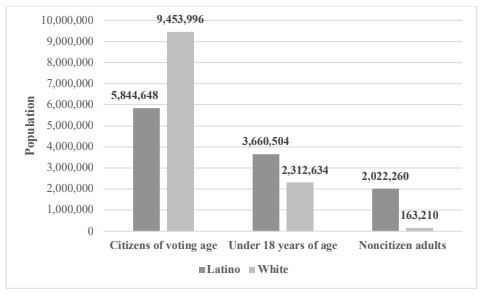

Source: 2019 American Community Survey 1-Year Estimates
The Latino-white age divide and the future of Texas politics
The age divide between Latinos and whites will be important over the long run. Currently, whites are the numerical majority in age groups 45 and older, with Latinos outnumbering whites in ages groups under 45. Nonetheless, a certain portion of Latinos between the ages of 25 and 44 are not U.S. citizens, with whites maintaining an advantage at these ages when we focus exclusively on citizens of voting age.
However, Latino citizens outnumber whites at all ages under 25. This is the sweet spot in the Latino demography. Among citizens who are 20 to 24 years of age, Latinos hold an advantage of 106,000 over whites. Latinos have a much greater numerical advantage over whites among persons who are today less than 18 years of age. Today, there are nearly 1.2 million more Latino citizens under 18 than whites. Add the 165,000 Latino children who currently are not U.S. citizens, provide them a path to citizenship, and the Latino advantage becomes even greater. Right now, more than 203,000 Latinos turn 18 every year, and the vast majority—96 percent—are U.S. citizens.
Figure 5. Texas Latino Population by Citizenship Status and Whites in Selected Age Categories, 2019
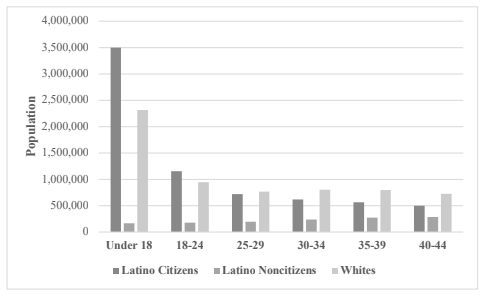

Source: 2019 American Community Survey 1-Year Estimates
Again, however, we need to realize that, despite these watershed numbers, this still represents potential political power. We need to ensure that today’s Latino youth are politically engaged and trained with a constant message from family, educators, community leaders, and nonprofit organizations about the importance of being civically active in their communities. We also need to press high schools to ensure that students who turn age 18 have the opportunity to register to vote. There is so much potential here, and it’s from the Latino youth that we will draw our future political leaders.
Results of 2020 Census and Latino role in Texas growth
The U.S. Census Bureau just released the national and state tallies of the population counted in the 2020 census. The state totals were used to allocate the 435 congressional seats. Seven states, including California, lost one congressional seat, while six states added one congressional seat, with Texas being the big winner, gaining two seats. Actually, Texas was projected to gain three congressional seats, but this did not materialize. My colleague Dudley Poston and I recently argued that Texas surrendered the third seat due to Governor Greg Abbott’s failure to invest funds and actively urge Texans to be counted in the census. It is very likely that Latinos, in particular, were undercounted in the census. Trump tried unsuccessfully to insert a citizenship question in the census, seeking to omit unauthorized immigrants from the population counts, in an effort to discourage Latinos of all statuses from participating in the census due to fear and uncertainty.
The growth in the state’s population over the past decade has been due primarily to growth in the Latino population and other groups of color. The latest population estimates broken down by race and ethnicity are for 2019. Between 2010 and 2019, Texas’s population rose by 15.3 percent. The Latino population grew by 21.8 percent, slightly faster than the Black population (19.3 percent), while the Asian population increased the most rapidly at 50.8 percent. The white population increased the slowest at 4.7 percent over the decade.
Texas added approximately 3.9 million persons to its population between 2010 and 2019. Latinos accounted for 54 percent of the overall state growth, with the other groups of color contributing nearly 33 percent (Figure 6). Overall, of every seven persons added to the Texas population between 2010 and 2019, approximately four were Latino, two others were non-Latino persons of color, and only one was white. Thus, Latinos and, more broadly, all persons of color were largely responsible for the two congressional seats that Texas received. It is anticipated that Republicans will use gerrymandering and related political ploys to dilute the Latino and Black vote this fall when political redistricting begins.
Figure 6. Percentage Distribution of the Texas Population Growth, 2010 to 2019
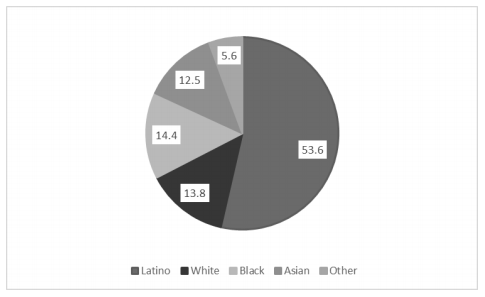

Source: 2010 Decennial Census and 2019 American Community Survey 1-Year Estimates
The Republican pushback
It is the demographic strength of Latinos that Republicans have tried to quash over the last three decades, with the passage of laws that suppress the Latino vote by making it more difficult to vote.
The current Texas legislative session has clearly shown the strategy that Republicans will take to keep Latinos from translating their growing numbers into political power. In the political sphere, Republicans have enacted voter suppression laws that serve to intimidate voters, encourage vigilante observers at the ballot box, and criminalize the process of voting—all efforts to quell the state’s demographic shift through voter suppression. In the educational sphere, Republicans have established policies that bar the teaching of critical race theory in public schools, with the intent of doing away with instruction of the role that institutionalized racism plays in the continual subjugation of people of color. These two pieces of legislation are intended to support the status quo and the Republican political dominance.
Come fall, as noted earlier, we will also see the gerrymandering and political ploys that Republicans will use in the drawing of congressional districts to enhance their political power. Never mind that the two new congressional seats that Texas received were due to the disproportionate growth of Latinos alongside African Americans and Asians.
Conclusion
I have provided an overview of where we, as Latinos, stand today, several months after the 2020 presidential election that held much possibility after the inroads made Democrats in the 2018 midterm election. The anticipation of turning Texas blue simply did not materialize. We learned important lessons from the November 2020 election, with the major realization being that our struggle to gain political power will be difficult. Our growing numbers will not simply turn into political power. The current Texas legislative session has resulted in Republican legislative weapons—voter suppression laws and the barring of the teaching of critical race theory in public schools–intended to ensure that Latinos do not translate their growing numbers into political power which would erode Republican dominance in the state.
Republicans have additionally developed policies that hurt people of color and the poor, including the opposition to the expansion of Medicaid and the improvement of labor conditions. The Republican leadership has particularly shown its lack of concern for Latinos, Blacks, and the poor during the pandemic. Throughout the COVID-19 months, Latinos, in particular, have accounted for the greatest number of persons statewide who have lost their lives to COVID-19. I estimated that, at the close of 2020, Latinos who had died from the disease had, on average, another 20 years of potential life left were it not for COVID-19.
We desperately need to elect political leaders who are going to invest in our future and who will keep us safe during a pandemic, or a severe winter storm like the recent one that immobilized the state and killed more than 100 Texans. We will all need to up our political game in order to turn the corner on this disastrous political course. The future of our families and our children is at stake.
***
Dr. Rogelio Sáenz is a sociologist and demographer. He is professor in the Department of Demography at the University of Texas at San Antonio. He has written extensively in the areas of demography, Latina/os, race, inequality, immigration, health disparities, aging, public policy, and social justice. Sáenz is co-author of Latinos in the United States: Diversity and Change and co-editor of the International Handbook of the Demography of Race and Ethnicity. He recently received the prestigious 2020 Saber es Poder Academic Excellence Award from the University of Arizona’s Department of Mexican American Studies. Twitter: @RogelioSaenz42.



Guys, I don’t care what you choose to call yourselves – Latinos, Tejanos, Cubanos, Hispanics – whatever. More of you turned toward Trump in 2020 as he, and Republicans, cruelly separated your children from parents at the border looking for asylum, not illegal immigration; as he called most of you murderers and rapists; as he carelessly forced you to work in Covid filled meat packing plants and farms with little or no protection, make it harder for you to vote and for your vote to count if they don’t like it, move to send your kids, who grew up knowing only this country, to be deported and, if you are of Cuban descent, as he closed Cuba up again to Americans who helped to fuel their economy and entrepreneurship. I’m sorry but I don’t get it.
[…] state in 2020, many were surprised to see Latinos in Texas’s Rio Grande Valley vote for Trump at a higher rate than in […]